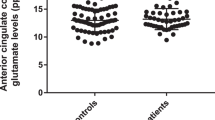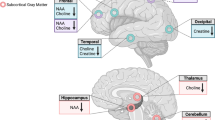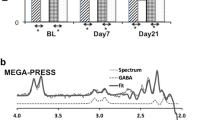Abstract
Converging neuropsychological and functional neuroimaging evidence indicates that the dorsal anterior cingulate cortex (dACC) is dysfunctional in drug-addicted populations. Few studies, however, have investigated the biochemical and physiological properties of the dACC in such populations. We used proton magnetic resonance spectroscopy (1H-MRS) together with functional magnetic resonance imaging (fMRI) to probe dACC biochemistry and physiological activity during performance of a behavioural control task in 24 opiate-dependent individuals (maintained on a stable dose of methadone or buprenorphine at the time of study) and 24 age, gender, intelligence and performance-matched healthy subjects. While both groups activated the dACC to comparable levels, the opiate-using group displayed relatively increased task-related activation of frontal, parietal and cerebellar regions, as well as reduced concentrations of dACC N-acetylaspartate and glutamate/glutamine. In addition, the opiate-using group failed to show the expected correlations between dACC activation and behavioural measures of cognitive control. These findings suggest that the dACC is biochemically and physiologically abnormal in long-term opiate-dependent individuals. Furthermore, opiate addicts required increased, perhaps compensatory, involvement of the fronto-parietal and cerebellar behavioural regulation network to achieve normal levels of task performance/behavioural control. These neurobiological findings may partly underpin key addiction-related phenomena, such as poor inhibitory control of drug-related behaviour in the face of adverse consequences, and may be of relevance to the design of future treatment studies.
This is a preview of subscription content, access via your institution
Access options
Subscribe to this journal
Receive 12 print issues and online access
$259.00 per year
only $21.58 per issue
Buy this article
- Purchase on Springer Link
- Instant access to full article PDF
Prices may be subject to local taxes which are calculated during checkout




Similar content being viewed by others
References
APA. Diagnostic and statistical manual of mental disorders, 4th edn (DSM-IV). American Psychiatric Association: Washington DC, 1994.
Robinson TE, Berridge KC . The neural basis of drug craving: an incentive-sensitization theory of addiction. Brain Res Brain Res Rev 1993; 18: 247–291.
Goldstein RZ, Volkow ND . Drug addiction and its underlying neurobiological basis: neuroimaging evidence for the involvement of the frontal cortex. Am J Psychiatry 2002; 159: 1642–1652.
Jentsch JD, Taylor JR . Impulsivity resulting from frontostriatal dysfunction in drug abuse: implications for the control of behavior by reward-related stimuli. Psychopharmacology (Berlin) 1999; 146: 373–390.
Lubman DI, Yücel M, Pantelis C . Addiction, a condition of compulsive behaviour? Neuroimaging and neuropsychological evidence of inhibitory dysregulation. Addiction 2004; 99: 1491–1502.
Robinson TE, Berridge KC . Addiction. Annu Rev Psychol 2003; 54: 25–53.
Volkow ND, Fowler JS . Addiction, a disease of compulsion and drive: involvement of the orbitofrontal cortex. Cereb Cortex 2000; 10: 318–325.
Volkow ND, Fowler JS, Wang GJ, Swanson JM . Dopamine in drug abuse and addiction: results from imaging studies and treatment implications. Mol Psychiatry 2004; 9: 557–569.
Botvinick MM, Cohen JD, Carter CS . Conflict monitoring and anterior cingulate cortex: an update. Trends Cogn Sci 2004; 8: 539–546.
Ridderinkhof KR, Ullsperger M, Crone EA, Nieuwenhuis S . The role of the medial frontal cortex in cognitive control. Science 2004; 306: 443–447.
Bush G, Shin LM . The Multi-Source Interference Task: an fMRI task that reliably activates the cingulo-frontal-parietal cognitive/attention network. Nature Protocols 2006; 1: 308–313.
Hester R, Garavan H . Executive dysfunction in cocaine addiction: evidence for discordant frontal, cingulate, and cerebellar activity. J Neurosci 2004; 24: 11017–11022.
Matochik JA, London ED, Eldreth DA, Cadet JL, Bolla KI . Frontal cortical tissue composition in abstinent cocaine abusers: a magnetic resonance imaging study. Neuroimage 2003; 19: 1095–1102.
Forman SD, Dougherty GG, Casey BJ, Siegle GJ, Braver TS, Barch DM et al. Opiate addicts lack error-dependent activation of rostral anterior cingulate. Biol Psychiatry 2004; 55: 531–537.
Garavan H, Ross TJ, Kaufman J, Stein EA . A midline dissociation between error-processing and response-conflict monitoring. Neuroimage 2003; 20: 1132–1139.
Lee TM, Zhou WH, Luo XJ, Yuen KS, Ruan XZ, Weng XC . Neural activity associated with cognitive regulation in heroin users: A fMRI study. Neurosci Lett 2005; 382: 211–216.
Price CJ, Friston KJ . Scanning patients with tasks they can perform. Hum Brain Mapp 1999; 8: 102–108.
Bush G, Shin LM, Holmes J, Rosen BR, Vogt BA . The Multi-Source Interference Task: validation study with fMRI in individual subjects. Mol Psychiatry 2003; 8: 60–70.
Heckers S, Weiss AP, Deckersbach T, Goff DC, Morecraft RJ, Bush G . Anterior cingulate cortex activation during cognitive interference in schizophrenia. Am J Psychiatry 2004; 161: 707–715.
Grachev ID, Kumar R, Ramachandran TS, Szeverenyi NM . Cognitive interference is associated with neuronal marker N-acetyl aspartate in the anterior cingulate cortex: an in vivo (1)H-MRS study of the Stroop Color-Word task. Mol Psychiatry 2001; 6: 439–529.
Barker PB . N-acetyl aspartate – a neuronal marker? Ann Neurol 2001; 49: 423–424.
Petroff OA, Errante LD, Kim JH, Spencer DD . N-acetyl-aspartate, total creatine, and myo-inositol in the epileptogenic human hippocampus. Neurology 2003; 60: 1646–1651.
Danielsen ER, Ross B . Magnetic Resonance Spectroscopy of Neurological Diseases, Ist edn. Marcel Dekker Inc: New York, 1999.
Gossop M . The development of a short opiate withdrawal scale (SOWS). Addict Behav 1990; 15: 487–490.
Gossop M, Darke S, Griffiths P, Hando J, Powis B, Hall W et al. The severity of dependence scale (SDS): psychometric properties of the SDS in English and Australian samples of heroin, cocaine and amphetamine users. Addiction 1995; 90: 607–614.
First MB, Spitzer RL, Gibbon M, Williams JB . Structured Clinical Interview for DSM-IV Axis I Disorders. In: American Psychiatric Press: Washington DC, 1997.
Wechsler D . Wechsler Abbreviated Scale of Intelligence Manual. The Psychological Corporation: San Antonio, 1999.
Tabachnick BG, Fidell LS . Using Multivariate Statistics, 4th edn. Allyn and Bacon: New York, 2001.
Jenkinson M, Bannister P, Brady M, Smith S . Improved optimization for the robust and accurate linear registration and motion correction of brain images. Neuroimage 2002; 17: 825–841.
Smith SM . Fast robust automated brain extraction. Hum Brain Mapp 2002; 17: 143–155.
Woolrich MW, Ripley BD, Brady M, Smith SM . Temporal autocorrelation in univariate linear modeling of FMRI data. Neuroimage 2001; 14: 1370–1386.
Worsley KJ, Evans AC, Marrett S, Neelin P . A three-dimensional statistical analysis for CBF activation studies in human brain. J Cereb Blood Flow Metab 1992; 12: 900–918.
Yücel M, Stuart GW, Maruff P, Velakoulis D, Crowe SF, Savage G et al. Hemispheric and gender-related differences in the gross morphology of the anterior cingulate/paracingulate cortex in normal volunteers: an MRI morphometric study. Cereb Cortex 2001; 11: 17–25.
Fornito A, Whittle S, Wood SJ, Velakoulis D, Pantelis C, Yücel M . The influence of sulcal variability on morphometry of the human anterior cingulate and paracingulate cortex. NeuroImage 2006; 33: 843–854.
Beckmann CF, Jenkinson M, Smith SM . General multilevel linear modeling for group analysis in FMRI. Neuroimage 2003; 20: 1052–1063.
Woolrich MW, Behrens TE, Beckmann CF, Jenkinson M, Smith SM . Multilevel linear modelling for FMRI group analysis using Bayesian inference. Neuroimage 2004; 21: 1732–1747.
Jenkinson M, Smith S . A global optimisation method for robust affine registration of brain images. Med Image Anal 2001; 5: 143–156.
Provencher SW . Estimation of metabolite concentrations from localized in vivo proton NMR spectra. Magn Reson Med 1993; 30: 672–679.
Kaufman JN, Ross TJ, Stein EA, Garavan H . Cingulate hypoactivity in cocaine users during a GO-NOGO task as revealed by event-related functional magnetic resonance imaging. J Neurosci 2003; 23: 7839–7843.
Bolla K, Ernst M, Kiehl K, Mouratidis M, Eldreth D, Contoreggi C et al. Prefrontal cortical dysfunction in abstinent cocaine abusers. J Neuropsychiatry Clin Neurosci 2004; 16: 456–464.
Wager TD, Sylvester CY, Lacey SC, Nee DE, Franklin M, Jonides J . Common and unique components of response inhibition revealed by fMRI. Neuroimage 2005; 27: 323–340.
Desmond JE, Chen SH, DeRosa E, Pryor MR, Pfefferbaum A, Sullivan EV . Increased frontocerebellar activation in alcoholics during verbal working memory: an fMRI study. Neuroimage 2003; 19: 1510–1520.
Sinha R, Lacadie C, Skudlarski P, Fulbright RK, Rounsaville BJ, Kosten TR et al. Neural activity associated with stress-induced cocaine craving: a functional magnetic resonance imaging study. Psychopharmacology (Berlin) 2005; 183: 171–180.
Sinha R, Lacadie C, Skudlarski P, Wexler BE . Neural circuits underlying emotional distress in humans. Ann NY Acad Sci 2004; 1032: 254–257.
Meyerhoff DJ, MacKay S, Bachman L, Poole N, Dillon WP, Weiner MW et al. Reduced brain N-acetylaspartate suggests neuronal loss in cognitively impaired human immunodeficiency virus-seropositive individuals: in vivo 1H magnetic resonance spectroscopic imaging. Neurology 1993; 43: 509–515.
Haselhorst R, Dursteler-MacFarland KM, Scheffler K, Ladewig D, Muller-Spahn F, Stohler R et al. Frontocortical N-acetylaspartate reduction associated with long-term i.v. heroin use. Neurology 2002; 58: 305–307.
O’Neill J, Eberling JL, Schuff N, Jagust W, Reed B, Soto G et al. Method to correlate 1H MRSI and 18FDG-PET. Magn Reson Med 2000; 43: 244–250.
Zhu XH, Chen W . Observed BOLD effects on cerebral metabolite resonances in human visual cortex during visual stimulation: a functional (1)H MRS study at 4T. Magn Reson Med 2001; 46: 841–847.
Moreno A, Ross BD, Bluml S . Direct determination of the N-acetyl-L-aspartate synthesis rate in the human brain by (13)C MRS and [1-(13)C]glucose infusion. J Neurochem 2001; 77: 347–350.
Baslow MH . N-acetylaspartate in the vertebrate brain: metabolism and function. Neurochem Res 2003; 28: 941–953.
Magistretti PJ, Pellerin L . Cellular mechanisms of brain energy metabolism. Relevance to functional brain imaging and to neurodegenerative disorders. Ann NY Acad Sci 1996; 777: 380–387.
Ernst T, Chang L, Leonido-Yee M, Speck O . Evidence for long-term neurotoxicity associated with methamphetamine abuse: A 1H MRS study. Neurology 2000; 54: 1344–1349.
Li SJ, Wang Y, Pankiewicz J, Stein EA . Neurochemical adaptation to cocaine abuse: reduction of N-acetyl aspartate in thalamus of human cocaine abusers. Biol Psychiatry 1999; 45: 1481–1487.
Dursteler-Mac Farland KM, Stormer R, Seifritz E, Hug I, Muller-Spahn F, Ladewig D et al. Opioid-associated effects on oxygen saturation. Addiction 2000; 95: 285–287.
Stohler R, Dursteler KM, Stormer R, Seifritz E, Hug I, Sattler-Mayr J et al. Rapid cortical hemoglobin deoxygenation after heroin and methadone injection in humans: a preliminary report. Drug Alcohol Depend 1999; 57: 23–28.
Buttner A, Mall G, Penning R, Weis S . The neuropathology of heroin abuse. Forensic Sci Int 2000; 113: 435–442.
Chang L, Ernst T, Grob CS, Poland RE . Cerebral (1)H MRS alterations in recreational 3, 4-methylenedioxymethamphetamine (MDMA, ‘ecstasy’) users. J Magn Reson Imag 1999; 10: 521–526.
Magalhaes AC . Functional magnetic resonance and spectroscopy in drug and substance abuse. Top Magn Reson Imag 2005; 16: 247–251.
Jang JH, Kwon JS, Jang DP, Moon WJ, Lee JM, Ha TH et al. A proton MRSI study of brain N-acetylaspartate level after 12 weeks of citalopram treatment in drug-naive patients with obsessive-compulsive disorder. Am J Psychiatry 2006; 163: 1202–1207.
Moore GJ, Bebchuk JM, Hasanat K, Chen G, Seraji-Bozorgzad N, Wilds IB et al. Lithium increases N-acetyl-aspartate in the human brain: in vivo evidence in support of bcl-2’s neurotrophic effects? Biol Psychiatry 2000; 48: 1–8.
Bertolino A, Callicott JH, Mattay VS, Weidenhammer KM, Rakow R, Egan MF et al. The effect of treatment with antipsychotic drugs on brain N-acetylaspartate measures in patients with schizophrenia. Biol Psychiatry 2001; 49: 39–46.
Koob GF . Neurobiology of addiction. Toward the development of new therapies. Ann NY Acad Sci 2000; 909: 170–185.
Petroff OA . GABA and glutamate in the human brain. Neuroscientist 2002; 8: 562–573.
Petroff OA, Mattson RH, Rothman DL . Proton MRS: GABA and glutamate. Adv Neurol 2000; 83: 261–271.
Gruetter R, Seaquist ER, Ugurbil K . A mathematical model of compartmentalized neurotransmitter metabolism in the human brain. Am J Physiol Endocrinol Metab 2001; 281: E100–E112.
Shen J, Petersen KF, Behar KL, Brown P, Nixon TW, Mason GF et al. Determination of the rate of the glutamate/glutamine cycle in the human brain by in vivo 13C NMR. Proc Natl Acad Sci USA 1999; 96: 8235–8240.
Lebon V, Petersen KF, Cline GW, Shen J, Mason GF, Dufour S et al. Astroglial contribution to brain energy metabolism in humans revealed by 13C nuclear magnetic resonance spectroscopy: elucidation of the dominant pathway for neurotransmitter glutamate repletion and measurement of astrocytic oxidative metabolism. J Neurosci 2002; 22: 1523–1531.
Magistretti PJ, Pellerin L . Cellular mechanisms of brain energy metabolism and their relevance to functional brain imaging. Philos Trans R Soc Lond B Biol Sci 1999; 354: 1155–1163.
Rothman DL, Sibson NR, Hyder F, Shen J, Behar KL, Shulman RG . In vivo nuclear magnetic resonance spectroscopy studies of the relationship between the glutamate-glutamine neurotransmitter cycle and functional neuroenergetics. Philos Trans R Soc Lond B Biol Sci 1999; 354: 1165–1177.
Kalivas PW . Glutamate systems in cocaine addiction. Curr Opin Pharmacol 2004; 4: 23–29.
Kalivas PW, McFarland K, Bowers S, Szumlinski K, Xi ZX, Baker D . Glutamate transmission and addiction to cocaine. Ann NY Acad Sci 2003; 1003: 169–175.
Tzschentke TM, Schmidt WJ . Glutamatergic mechanisms in addiction. Mol Psychiatry 2003; 8: 373–382.
Pennartz CM, McNaughton BL, Mulder AB . The glutamate hypothesis of reinforcement learning. Prog Brain Res 2000; 126: 231–253.
Williams ZM, Bush G, Rauch SL, Cosgrove GR, Eskandar EN . Human anterior cingulate neurons and the integration of monetary reward with motor responses. Nat Neurosci 2004; 7: 1370–1375.
Bush G, Vogt BA, Holmes J, Dale AM, Greve D, Jenike MA et al. Dorsal anterior cingulate cortex: a role in reward-based decision making. Proc Natl Acad Sci USA 2002; 99: 523–528.
Rogers RD, Ramnani N, Mackay C, Wilson JL, Jezzard P, Carter CS et al. Distinct portions of anterior cingulate cortex and medial prefrontal cortex are activated by reward processing in separable phases of decision-making cognition. Biol Psychiatry 2004; 55: 594–602.
Amiez C, Joseph JP, Procyk E . Reward encoding in the monkey anterior cingulate cortex. Cereb Cortex 2006; 16: 1040–1055.
Haber SN, Kim KS, Mailly P, Calzavara R . Reward-related cortical inputs define a large striatal region in primates that interface with associative cortical connections, providing a substrate for incentive-based learning. J Neurosci 2006; 26: 8368–8376.
Shidara M, Richmond BJ . Anterior cingulate: single neuronal signals related to degree of reward expectancy. Science 2002; 296: 1709–1711.
Shima K, Tanji J . Role for cingulate motor area cells in voluntary movement selection based on reward. Science 1998; 282: 1335–1338.
Acknowledgements
This research was supported by the National Health and Medical Research Council (NHMRC) of Australia (I.D. 236175), a Pfizer Neuroscience Research Grant, the Colonial Foundation, and the Ian Potter Foundation. Dr Yücel is supported by a NHMRC Program Grant (I.D. 350241). Dr Harrison is supported by a NHMRC Training Award (I.D. 400420). Dr Fornito is supported by an Australian Postgraduate Award, J.N. Peters Fellowship, and an NHMRC Training Award (I.D. 454797). Dr Wood is supported by an NHMRC Clinical Career Development Award and a NARSAD Young Investigator Award. Dr Forman is supported by the US Department of Veterans’ Affairs VISN4 MIRECC. Neuroimaging analysis was facilitated by the Neuropsychiatry Imaging Laboratory managed by Ms Bridget Soulsby at the Melbourne Neuropsychiatry Centre and supported by Neurosciences Victoria. The authors would also like to thank Trudi MacKenzie and Antonietta Scaffidi for their efforts in patient recruitment and assessment, Dr Steven Grant for his advice on study design, The Mental Health Research Institute for research and administrative support and NIDA for providing a travel scholarship to present these findings at the College on Problems of Drug Dependence (CPDD) conference, San Juan, Puerto Rico.
Author information
Authors and Affiliations
Corresponding author
Rights and permissions
About this article
Cite this article
Yücel, M., Lubman, D., Harrison, B. et al. A combined spectroscopic and functional MRI investigation of the dorsal anterior cingulate region in opiate addiction. Mol Psychiatry 12, 691–702 (2007). https://doi.org/10.1038/sj.mp.4001955
Received:
Revised:
Accepted:
Published:
Issue Date:
DOI: https://doi.org/10.1038/sj.mp.4001955
Keywords
This article is cited by
-
High-definition transcranial direct current stimulation of the dorsal anterior cingulate cortex modulates decision-making and executive control
Brain Structure and Function (2022)
-
Prevalence and risk factors for khat use among youth students in Ethiopia: systematic review and meta-analysis, 2018
Annals of General Psychiatry (2020)
-
No evidence of abnormal metabolic or inflammatory activity in the brains of patients with rheumatoid arthritis: results from a preliminary study using whole-brain magnetic resonance spectroscopic imaging (MRSI)
Clinical Rheumatology (2020)
-
Can neuroimaging help combat the opioid epidemic? A systematic review of clinical and pharmacological challenge fMRI studies with recommendations for future research
Neuropsychopharmacology (2019)
-
Neural correlates of interference resolution in the multi-source interference task: a meta-analysis of functional neuroimaging studies
Behavioral and Brain Functions (2018)



